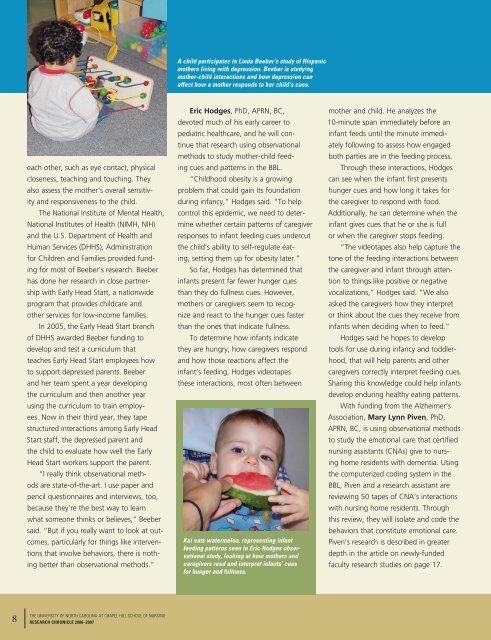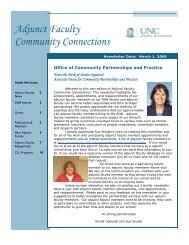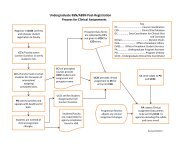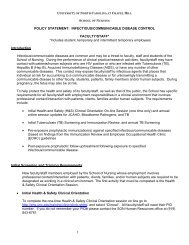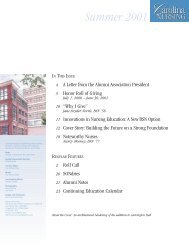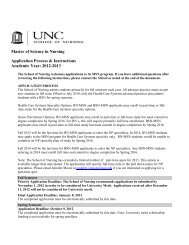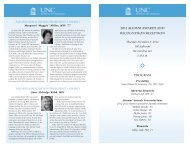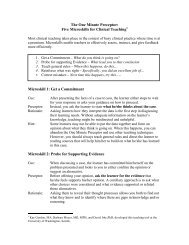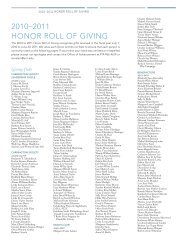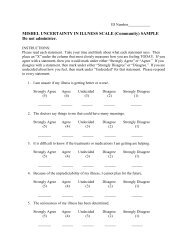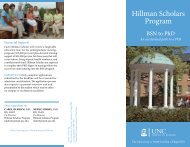Research Chronicle, 2006 - School of Nursing - University of North ...
Research Chronicle, 2006 - School of Nursing - University of North ...
Research Chronicle, 2006 - School of Nursing - University of North ...
You also want an ePaper? Increase the reach of your titles
YUMPU automatically turns print PDFs into web optimized ePapers that Google loves.
8<br />
each other, such as eye contact, physical<br />
closeness, teaching and touching. They<br />
also assess the mother’s overall sensitivity<br />
and responsiveness to the child.<br />
The National Institute <strong>of</strong> Mental Health,<br />
National Institutes <strong>of</strong> Health (NIMH, NIH)<br />
and the U.S. Department <strong>of</strong> Health and<br />
Human Services (DHHS), Administration<br />
for Children and Families provided funding<br />
for most <strong>of</strong> Beeber’s research. Beeber<br />
has done her research in close partnership<br />
with Early Head Start, a nationwide<br />
program that provides childcare and<br />
other services for low-income families.<br />
In 2005, the Early Head Start branch<br />
<strong>of</strong> DHHS awarded Beeber funding to<br />
develop and test a curriculum that<br />
teaches Early Head Start employees how<br />
to support depressed parents. Beeber<br />
and her team spent a year developing<br />
the curriculum and then another year<br />
using the curriculum to train employees.<br />
Now in their third year, they tape<br />
structured interactions among Early Head<br />
Start staff, the depressed parent and<br />
the child to evaluate how well the Early<br />
Head Start workers support the parent.<br />
“I really think observational methods<br />
are state-<strong>of</strong>-the-art. I use paper and<br />
pencil questionnaires and interviews, too,<br />
because they’re the best way to learn<br />
what someone thinks or believes,” Beeber<br />
said. “But if you really want to look at outcomes,<br />
particularly for things like interventions<br />
that involve behaviors, there is nothing<br />
better than observational methods.”<br />
THE UNIVERSITY OF NORTH CAROLINA AT CHAPEL HILL SCHOOL OF NURSING<br />
RESEARCH CHRONICLE <strong>2006</strong>–2007<br />
A child participates in Linda Beeber’s study <strong>of</strong> Hispanic<br />
mothers living with depression. Beeber is studying<br />
mother-child interactions and how depression can<br />
affect how a mother responds to her child’s cues.<br />
Eric Hodges, PhD, APRN, BC,<br />
devoted much <strong>of</strong> his early career to<br />
pediatric healthcare, and he will continue<br />
that research using observational<br />
methods to study mother-child feeding<br />
cues and patterns in the BBL.<br />
“Childhood obesity is a growing<br />
problem that could gain its foundation<br />
during infancy,” Hodges said. “To help<br />
control this epidemic, we need to determine<br />
whether certain patterns <strong>of</strong> caregiver<br />
responses to infant feeding cues undercut<br />
the child’s ability to self-regulate eating,<br />
setting them up for obesity later.”<br />
So far, Hodges has determined that<br />
infants present far fewer hunger cues<br />
than they do fullness cues. However,<br />
mothers or caregivers seem to recognize<br />
and react to the hunger cues faster<br />
than the ones that indicate fullness.<br />
To determine how infants indicate<br />
they are hungry, how caregivers respond<br />
and how those reactions affect the<br />
infant’s feeding, Hodges videotapes<br />
these interactions, most <strong>of</strong>ten between<br />
Kai eats watermelon, representing infant<br />
feeding patterns seen in Eric Hodges observational<br />
study, looking at how mothers and<br />
caregivers read and interpret infants’ cues<br />
for hunger and fullness.<br />
mother and child. He analyzes the<br />
10-minute span immediately before an<br />
infant feeds until the minute immediately<br />
following to assess how engaged<br />
both parties are in the feeding process.<br />
Through these interactions, Hodges<br />
can see when the infant first presents<br />
hunger cues and how long it takes for<br />
the caregiver to respond with food.<br />
Additionally, he can determine when the<br />
infant gives cues that he or she is full<br />
or when the caregiver stops feeding.<br />
“The videotapes also help capture the<br />
tone <strong>of</strong> the feeding interactions between<br />
the caregiver and infant through attention<br />
to things like positive or negative<br />
vocalizations,” Hodges said. “We also<br />
asked the caregivers how they interpret<br />
or think about the cues they receive from<br />
infants when deciding when to feed.”<br />
Hodges said he hopes to develop<br />
tools for use during infancy and toddlerhood,<br />
that will help parents and other<br />
caregivers correctly interpret feeding cues.<br />
Sharing this knowledge could help infants<br />
develop enduring healthy eating patterns.<br />
With funding from the Alzheimer’s<br />
Association, Mary Lynn Piven, PhD,<br />
APRN, BC, is using observational methods<br />
to study the emotional care that certified<br />
nursing assistants (CNAs) give to nursing<br />
home residents with dementia. Using<br />
the computerized coding system in the<br />
BBL, Piven and a research assistant are<br />
reviewing 50 tapes <strong>of</strong> CNA’s interactions<br />
with nursing home residents. Through<br />
this review, they will isolate and code the<br />
behaviors that constitute emotional care.<br />
Piven’s research is described in greater<br />
depth in the article on newly-funded<br />
faculty research studies on page 17.


